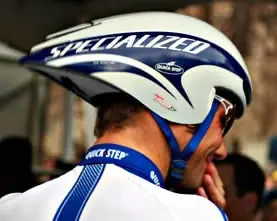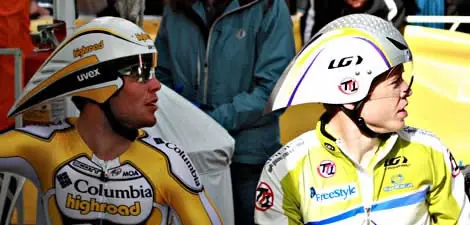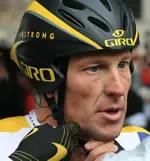After the opening Prologue time trial of the 2009 Amgen Tour of California, Road Bike Action took a look at some the aerodynamic helmets the professional riders wore. Despite many similarities, it was surprising to see the different approaches manufactures take to cheat the wind.
Tom Boonen and the rest of the Quick Step have switched to Specialized helmets for the 2009 season. The yet-to-be-released Specialized time trial helmet could be the most sought after time trial helmet ever. Wind tunnel data ranks the Specialized as one of the most the aerodynamic helmets in the professional peloton.

Currently, the helmet is only available to Specialized sponsored teams, but word is they will be releasing it to the public in 2010.
The Uvex time trial helmet features a classic chrono design with a long tail that lies flat on the rider's back and is covered on the bottom. The Uvex also features low sides to cover the rider's ears and includes an integrated face shield. Unique to the Uvex is the absence of frontal vents.

Mark Cavendish (left) waits for the start of the Prologue with Team Type 1 rider Phil Southerland.
At the 2009 Tour of California, the Rock Racing and Team Type 1 debuted the Louis Garneau Superleggera time trial helmet. The Superleggera has two huge front vent inlets and three large back vent outlets for maximum airflow.
Compared to its predecessor the Rocket air, the Superleggera weighs 50-grams less, and has the center of gravity adjusted to create less fatigue at the neck area and make it easier for the rider to maintain an aero position.
The most significantly addition compared to the Rocket air is that of a texturized frontal area that increases laminar airflow. The surface roughness causes the flow to transition from laminar to turbulent. The turbulent flow has more energy than the laminar flow, and thus the flow of air stays attached to the helmet longer.

The Giro Advantage 2 first made its debut in the 2006 Tour de France after being developed with countless wind tunnel hours and the feedback of professional riders—including Lance Armstrong.
Through tunnel sessions with Lance Armstrong and other professional riders, the Advantage 2 was designed to be as aerodynamic as Giro's helmet fairings (a helmet shell with no impact absorbing material). The result was that the Advantage 2 produced remarkably similar drag numbers to the fairing design, and is one of the fastest helmets on the market.


